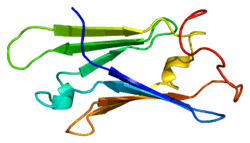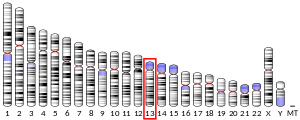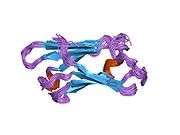SUGT1
Suppressor of G2 allele of SKP1 homolog is a protein that in humans is encoded by the SUGT1 gene.[4][5]
| SUGT1 | |||||||||||||||||||||||||
|---|---|---|---|---|---|---|---|---|---|---|---|---|---|---|---|---|---|---|---|---|---|---|---|---|---|
 | |||||||||||||||||||||||||
| |||||||||||||||||||||||||
| Identifiers | |||||||||||||||||||||||||
| Aliases | SUGT1, SGT1, SGT1 homolog, MIS12 kinetochore complex assembly cochaperone | ||||||||||||||||||||||||
| External IDs | OMIM: 604098 MGI: 1915205 HomoloGene: 4877 GeneCards: SUGT1 | ||||||||||||||||||||||||
| |||||||||||||||||||||||||
| |||||||||||||||||||||||||
| Orthologs | |||||||||||||||||||||||||
| Species | Human | Mouse | |||||||||||||||||||||||
| Entrez | |||||||||||||||||||||||||
| Ensembl |
| ||||||||||||||||||||||||
| UniProt | |||||||||||||||||||||||||
| RefSeq (mRNA) | |||||||||||||||||||||||||
| RefSeq (protein) | |||||||||||||||||||||||||
| Location (UCSC) | Chr 13: 52.65 – 52.7 Mb | n/a | |||||||||||||||||||||||
| PubMed search | [2] | [3] | |||||||||||||||||||||||
| Wikidata | |||||||||||||||||||||||||
| |||||||||||||||||||||||||
Function
This gene is homologous to the yeast gene SGT1, which encodes a protein involved in kinetochore function and required for the G1/S and G2/M transitions. Complementation studies suggest that the human protein has similar functions.[5]
References
- GRCh38: Ensembl release 89: ENSG00000165416 - Ensembl, May 2017
- "Human PubMed Reference:". National Center for Biotechnology Information, U.S. National Library of Medicine.
- "Mouse PubMed Reference:". National Center for Biotechnology Information, U.S. National Library of Medicine.
- Kitagawa K, Skowyra D, Elledge SJ, Harper JW, Hieter P (July 1999). "SGT1 encodes an essential component of the yeast kinetochore assembly pathway and a novel subunit of the SCF ubiquitin ligase complex". Molecular Cell. 4 (1): 21–33. doi:10.1016/S1097-2765(00)80184-7. PMID 10445024.
- "Entrez Gene: SUGT1 SGT1, suppressor of G2 allele of SKP1 (S. cerevisiae)".
- Nowotny M, Spiechowicz M, Jastrzebska B, Filipek A, Kitagawa K, Kuznicki J (July 2003). "Calcium-regulated interaction of Sgt1 with S100A6 (calcyclin) and other S100 proteins". The Journal of Biological Chemistry. 278 (29): 26923–8. doi:10.1074/jbc.M211518200. PMID 12746458.
Further reading
- Gevaert K, Goethals M, Martens L, Van Damme J, Staes A, Thomas GR, Vandekerckhove J (May 2003). "Exploring proteomes and analyzing protein processing by mass spectrometric identification of sorted N-terminal peptides". Nature Biotechnology. 21 (5): 566–9. doi:10.1038/nbt810. PMID 12665801.
- Nowotny M, Spiechowicz M, Jastrzebska B, Filipek A, Kitagawa K, Kuznicki J (July 2003). "Calcium-regulated interaction of Sgt1 with S100A6 (calcyclin) and other S100 proteins". The Journal of Biological Chemistry. 278 (29): 26923–8. doi:10.1074/jbc.M211518200. PMID 12746458.
- Niikura Y, Kitagawa K (December 2003). "Identification of a novel splice variant: human SGT1B (SUGT1B)". DNA Sequence. 14 (6): 436–41. doi:10.1080/10425170310001623644. PMID 15018354.
- Zou X, Ji C, Wang L, Wu M, Zheng H, Xu J, Jin F, Gu S, Ying K, Xie Y, Mao Y (April 2004). "Molecular cloning and characterization of SGT1.2, a novel splice variant of Homo sapiens SGT1". DNA Sequence. 15 (2): 140–3. doi:10.1080/1042517032000160215. PMID 15346769.
- Rush J, Moritz A, Lee KA, Guo A, Goss VL, Spek EJ, Zhang H, Zha XM, Polakiewicz RD, Comb MJ (January 2005). "Immunoaffinity profiling of tyrosine phosphorylation in cancer cells". Nature Biotechnology. 23 (1): 94–101. doi:10.1038/nbt1046. PMID 15592455.
- Beausoleil SA, Villén J, Gerber SA, Rush J, Gygi SP (October 2006). "A probability-based approach for high-throughput protein phosphorylation analysis and site localization". Nature Biotechnology. 24 (10): 1285–92. doi:10.1038/nbt1240. PMID 16964243.
- da Silva Correia J, Miranda Y, Leonard N, Ulevitch R (April 2007). "SGT1 is essential for Nod1 activation". Proceedings of the National Academy of Sciences of the United States of America. 104 (16): 6764–9. doi:10.1073/pnas.0610926104. PMC 1871859. PMID 17420470.
- Spiechowicz M, Zylicz A, Bieganowski P, Kuznicki J, Filipek A (June 2007). "Hsp70 is a new target of Sgt1--an interaction modulated by S100A6". Biochemical and Biophysical Research Communications. 357 (4): 1148–53. doi:10.1016/j.bbrc.2007.04.073. PMID 17466273.
This article is issued from Wikipedia. The text is licensed under Creative Commons - Attribution - Sharealike. Additional terms may apply for the media files.


